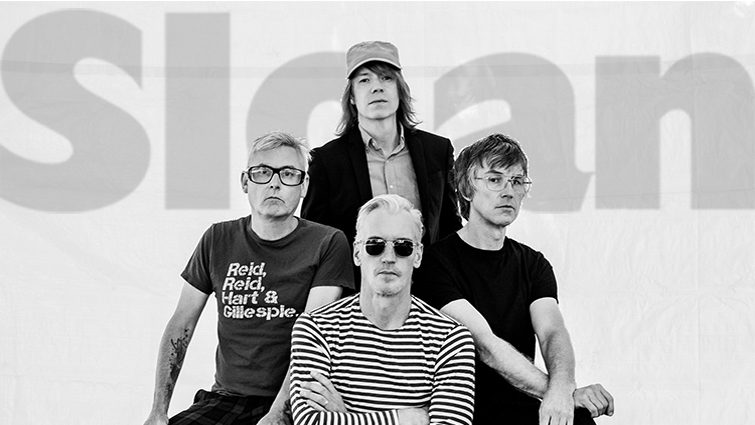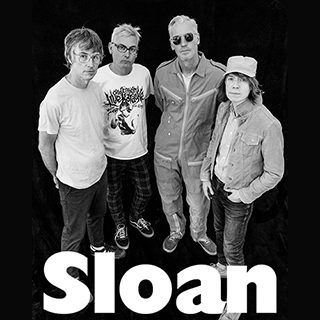
Sloan

$59.00 Per Person
Including fees & charges
When attempting to provide an overview of a big story – one that encompasses both the myriad achievements of its subjects over a span of several decades and the impacts of those achievements – you can take two routes. There’s the “just the facts” approach, where you list off the people, places, and things that populate the tale, and then there’s another road that winds through the hows and whys behind the names and numbers. Looking at the story of Canadian indie rock institution Sloan, the temptation to look through both lenses is strong.
For those who prefer the factual take, there are certainly enough noteworthy events and experiences peppered through the bands over 30-year history to make for a good yarn. There are the various musical incarnations that flowered in the rather fertile indie music scene in the Halifax, Nova Scotia of the late 1980s and early 1990s that brought bassist and vocalist Chris Murphy, guitarists/vocalists Jay Ferguson and Patrick Pentland, and drummer/vocalist Andrew Scott together – bands such as The Deluxe Boys, Happy Co., No Damn Fears and Kearney Lake Road that anyone of a certain vintage who hails from the Canadian coastal city will recall fondly.
There’s the first recorded appearance in 1991 of what could be their earliest signature tune, “Underwhelmed,” that landed on a very hard-to-find compilation of Halifax acts called Hear and Now, which – combined with a chaotic but explosive self-promoted showcase during a Halifax music festival – brought them to the attention of various record labels, including the label du jour of the early 1990s, Geffen Records imprint DGC.
That tidbit leads to the next chain of events – signing to DGC and releasing their first album, 1992’s Smeared, recorded in the same home studio of Halifax producer Terry Pulliam as the Hear and Now session at roughly the same time, but preceding that with their own indie release, the Peppermint EP, on their own label, murderecords. Propelled by support from a newly influential network of college radio stations and indie-friendly print publications, the band toured the U.S. and Canada before setting up shop in New York City to record their second full-length, Twice Removed, with producer Jim Rondinelli.
And here we have the first big plot twist of the fact-based version of the Sloan story. Somewhat bored with the shoegazey, Abba-meets-My Bloody Valentine approach to their songwriting that was so well documented on Smeared, and immersing themselves in the bare-boned sonic templates of The Beatles’ “White Album” and Fleetwood Mac’s Rumours while traversing the continent in tour vans, the band turned in to DGC an album that was stripped of the manic, fizzy energy of the debut – replaced with a clarity and cleverness that augmented the catchiness of such songs as “Coax Me”, “Snowsuit Sound” and “People of the Sky”. But that approach flew in the face of what was “shifting units” at the time, and DGC was, to use a predictable pun, underwhelmed by an album that would go on to be named “the best Canadian album of all time” by Canada’s Chart Magazine.
While this turn of events would kill most bands (and has in many cases), for Sloan it led to perhaps the most impressive array of facts and figures in the story to date. Discouraged by response to the new album by their label and staring down the prospect of finishing out a contract with a disinterested benefactor, the band contemplated winding down in 1995, playing a handful of rapturously received shows and recording one last hurrah in the Halifax studio of producer/engineer Laurence Currie for an album to released on murderecords. That album, 1996’s One Chord to Another, would prove to be a benchmark in the Sloan story, racking up hit singles in “The Good in Everyone,” “Everything You’ve Done Wrong” and “The Lines You Amend” and giving the band their first gold album, and their best-selling album to date.
From there, the facts lead to the next big chapter in the story – the release of Navy Blues in 1998 and the band’s embrace of riff rock, leading to such arena-ready singles as “Money City Maniacs” and “She Says What She Means” resulting in another gold-plus album and tours of Japan, the UK and Australia. That success spurred the band on to greater artistic heights – the highly regarded Between the Bridges came quickly after, in 1999 – and a glance at the band’s discography further illustrates the scope of ambition within Sloan when it comes to their recorded output, with not one but two double albums in their studio recordings (2006’s Never Hear the End of It and 2014’s Commonwealth). Celebrating their 20th anniversary with 2011’s The Double Cross, the band began to explore its own legacy with sumptuous reissues of Twice Removed, One Chord to Another and Navy Blues, while also striving to add to that legacy with such strong, strident efforts as 2018’s 12 and 2022's Steady.
So those are the facts. But between those bridges there’s a wealth of information and experience that takes this story somewhere else – beyond the realm of “successful Canadian rock band” to “venerable indie rock institution” status. And yes, that’s the second time we’ve used the word “institution,” but hear us out.
Sloan is that rare band that has an ethos that accompanies its discography. From those early gigs in the basement of the Nova Scotia College of Art and Design to the present day, the band has eschewed the typical star-making machinery that puts one member as the driving creative force, with the rest of the band serving as trusted accomplices. Sloan boasts four singing, songwriting multi-instrumentalists, all of whom contribute to the final fabric woven into each album. As a result you have a depth and breadth of music that defies simple characterizations like “power pop” or even “indie rock” – 2001’s Pretty Together balances ornate chamber pop with fist-pumping rockers, while later efforts such as Never Hear the End of It and 12 contain multitudes in their track listings, ranging from Dylanesque streams of consciousness to short, sharp shocks of hardcore. But somehow, it all remains quintessentially Sloan.
That comes down to another integral part of this ethos we’re banging on about. From day one, the lineup of the band has remained unchanged. Through thick and thin, geographical relocation from Halifax to Toronto and who knows how many challenges along the way, the band has stayed intact. Sure, many can point to the band’s practice, perhaps inspired by their hardcore and post-rock heroes, of splitting the earnings evenly. But there’s more at play here. There seems to be a shared understanding between both the band members themselves and their devoted audiences around the world that Sloan is the sum of its parts, and if one member were to leave for whatever reason, that would bring the story to a close. You can call this commitment – to an ideal, to friendships, to the music itself. But it resonates through the songs, through the live performances, and through the relationship the band has with their fans.
Ultimately, whichever route appeals most to you when looking at the big story that is Sloan, as you wind your way to the present day, there is one last thing worth considering – one bit of news that could be the starting point for the next attempt at approaching this story in the years ahead. In 2025, some 30-plus years on from when it all began, with the release of their 14th full-length album Based on the Best Seller, the tale is – thankfully – far from over.
“It's not a challenge to make a 14th album,” Jay Ferguson says, “But sometimes it's a challenge to think of a new overarching theme for a 14th album (and The Kinks’ 14th album was Soap Opera, essentially a TV play and complete story arc set to music, so clearly Ray Davies didn't have that problem). Our band has the capability to perform different styles within the rock/pop (or pop/rock) sphere, but it's often hard to harness the group to adhere to one particular style or theme. That's okay though. With four songwriters, we tend to make music that perhaps doesn't always naturally hang together under one (opened) umbrella but that's our style, and that style is continued on Based on the Best Seller. Nevertheless, whether it's Chris harmonizing on my songs, Patrick harmonizing on Chris' songs or Chris and our keyboardist Gregory vocally backing-up Andrew, I think those elements help tie together this (and previous) Sloan albums.”
Back to Event Listings


